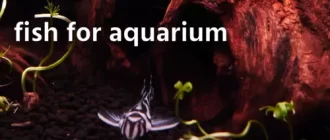Have you ever heard a faint howl while wandering near freshwater habitats in Central America? No, it’s not a werewolf or any land-based carnivore; it might be the enigmatic Wolf Cichlid asserting its presence! The underwater world has its fair share of unique and exciting creatures, but few can rouse as much passion for fish enthusiasts as the notorious Wolf Cichlid.
As captivating as it is fierce, the Wolf Cichlid, also known as Parachromis dovii, is one of the largest and most formidable cichlid species in the world.
We’ll dive deep into the wild waters of Central America, unearthing the nice nature of the Wolf Cichlid, and discovering why this particular fish has amassed such a devoted following. So, strap on your fins, and let’s embark on our aquatic adventure!
Name and Habitat of the Wolf Cichlid

The Wolf Cichlid (Parachromis dovii) is a fascinating species native to Central America, with its habitat ranging from the Atlantic slopes of the Aguan River in Honduras to the Moín River in Costa Rica and from the Pacific slopes of the Yeguare River in Honduras to the Bebedero River in Costa Rica. This powerful fish thrives in freshwater lakes and lower to middle river valleys, preferring tropical temperatures of 21-37°C (75-82°F). The Wolf Cichlid’s unique ability to dig caverns and its highly piscivorous diet make it an intriguing species to observe and study in its natural habitat.
Unique Characteristics and Appearance of the Wolf Cichlid
The Wolf Cichlid, scientifically known as Parachromis dovii, boasts a unique combination of beauty and predatory prowess that sets it apart from other freshwater fish species. One of the most striking features of these magnificent creatures is their vivid coloration, which varies from blue, green, and yellow hues, to brilliant reds and oranges. They are also among the largest cichlids, growing up to a staggering 30 inches in length. Apart from their impressive size and captivating colors, Wolf Cichlids are renowned for their intelligence and behavioral traits, often demonstrating playful and seemingly trained behaviors. This blend of beauty, power, and charm is what makes the Wolf Cichlid a sought-after addition to the aquariums of experienced fish enthusiasts.
Aggressiveness: How the Wolf Cichlid Behaves with Other Fish
The Wolf Cichlid, or Dovii Cichlid, is renowned for its aggressive nature, which can make it a formidable tank mate for other fish. Often considered the meanest fish to keep in an aquarium, Wolf Cichlids are highly territorial, intelligent, and capable of inflicting significant damage to other inhabitants. Their combative behavior is primarily driven by resource scarcity or competition, leading to increased aggression in overstocked tanks. As a result, it is generally not recommended to house them with other hostile predators such as the Jaguar Cichlid.
Instead, providing them with a spacious and well-structured environment can help mitigate their aggressiveness and ensure a more harmonious living space for these fascinating creatures.
Lifespan of the Wolf Cichlid
The Wolf Cichlid, or Dovii Cichlid, is a stunning freshwater species renowned for its long lifespan, making it a popular choice for experienced aquarists seeking a long-term commitment.

These magnificent creatures can live between 24 and 30 years on average, with some even surpassing the 30-year mark under pristine living conditions. However, it is important to note that the lifespan of a Wolf Cichlid heavily relies on genetics and the quality of care provided by the owner.
Meeting their distinct care needs and ensuring a healthy environment is vital for these fish to thrive, making them an exciting challenge for dedicated aquarium enthusiasts.
Tank Size and Requirements for Caring for the Wolf Cichlid
Step 1: Choose the Right Tank Size
Wolf Cichlids are large fish, growing up to 30 inches in length. Hence, they require ample swimming space to stay healthy. A minimum tank size of 125 gallons is highly recommended for a single Wolf Cichlid. If you plan to keep tank mates, opt for a larger tank to accommodate everyone comfortably.
Step 2: Ensure Optimal Water Parameters
Wolf Cichlids thrive in water temperatures ranging from 75-82°F with a pH level of 6.8-7.8. Ensure a stable environment by installing a high-quality heater and monitoring the water parameters regularly.
Step 3: Create a Comfortable Habitat
These intelligent fish need hiding spots and territories in their tank. Include items like large rocks, caves or PVC pipes to create hiding places. Add artificial or live plants for additional shelter and to make your Wolf Cichlid feel at home.
Step 4: Establish a Powerful Filtration System
A robust filtration system is crucial for maintaining water quality and ensuring the well-being of your Wolf Cichlid. Invest in a high-quality filter capable of managing large volumes of water, and performing regular maintenance to keep the system in top condition.
Step 5: Consistently Monitor and Maintain
To provide consistent care for your Wolf Cichlids, keep a close eye on their health and behavior, and perform regular water testing and changes. Observing these guidelines will ensure a long, healthy life for your captivating fish.
Ideal Temperature and pH Range for the Wolf Cichlid
When it comes to creating the perfect environment for your Wolf Cichlid (Parachromis dovii), it is essential to maintain the ideal temperature and pH range within their tank. These spectacular fish thrive in water temperatures between 75 and 82 degrees Fahrenheit (24 to 28 degrees Celsius). Maintaining a stable temperature within this range promotes their overall health, keeping them active and comfortable.
In addition to temperature, the ideal pH range for a Wolf Cichlid is 6.8 to 7.8. It is crucial to monitor and maintain this slightly alkaline water condition in order to ensure a healthy habitat for your aquatic pet. By providing optimal temperature and pH conditions, your Wolf Cichlid will thrive and showcase its full beauty and fascinating behavior in your aquarium.
What to Feed the Wolf Cichlid
- Crickets: Providing essential proteins and nutrients, crickets are an excellent choice for your carnivorous Wolf Cichlid.
- Crayfish: Rich in protein and minerals, crayfish are a healthy and indulgent treat that Wolf Cichlids love.
- Mussels: Offering essential vitamins and nutrients, mussels are a protein-packed meal that boosts your fish’s immune system.
- Large Staple Cichlid Pellets: Perfect for everyday feeding, these pellets contain essential nutrients to maintain a balanced diet for your Wolf Cichlid.
- Whitebait: Brimming with proteins and healthy fats, whitebait is a satisfying meal for your Wolf Cichlid.
- Prawns: Delivering essential nutrients, like protein and Omega-3 fatty acids, prawns help keep your Wolf Cichlid vibrant and healthy.
- Silversides: Providing important vitamins and minerals, silversides are a rich and delicious treat that your Wolf Cichlid will relish.
Breeding and Mating Habits of the Wolf Cichlid
With proper care and environment, these carnivorous fish can produce fascinating offspring, displaying unique bonding interactions between parents and fry.
- Observe the Courtship – Witness the intricate dances, the gill flaring, and jaw locking as the Wolf Cichlids engage in an amazing display of courtship, signalling their readiness to mate.
- Provide Spawning Sites – Offer caves and PVC pipes to encourage spawning, although they may choose other locations such as the bare tank glass.
- Witness the Spawn – A 3-inch female can produce up to 200 fry in one batch, while adult females may lay up to 1000+ eggs at a time. The male and female remain very protective over their offspring, even attacking intruders.
- Raise the Fry – Feed the fry with crushed flakes, crushed freeze-dried brine, and crushed freeze-dried mysis shrimp for optimal growth and development.
If you’re prepared for the challenge, breeding Wolf Cichlids can be a rewarding and enriching experience, showcasing the captivating habits of this magnificent species.
Cost of Wold Cichlids
Wolf Cichlids are undoubtedly fascinating and captivating fish for avid aquarists, but they do come at a cost. While the price of the fish itself can range from $20 to $50, the real expenditure lies in the maintenance and care required to keep these stunning creatures thriving. It is essential to invest in a large and spacious tank of at least 125 gallons, along with appropriate filtration systems, heaters, and strong tank decor to withstand their aggressive nature. Additionally, their carnivorous diet demands a variety of high-quality, protein-rich foods to ensure their health and vitality. The overall expense of keeping a Wolf Cichlid may be steep, but the experience of owning one of these amazing fish is truly priceless.





